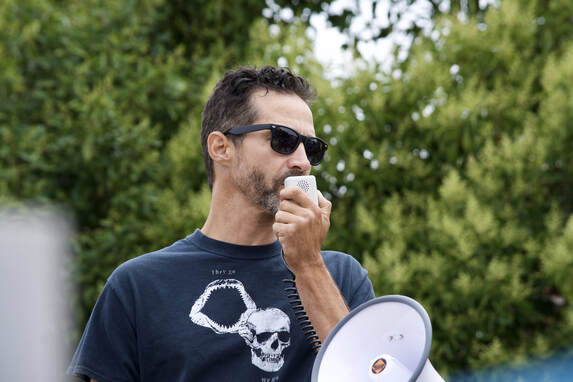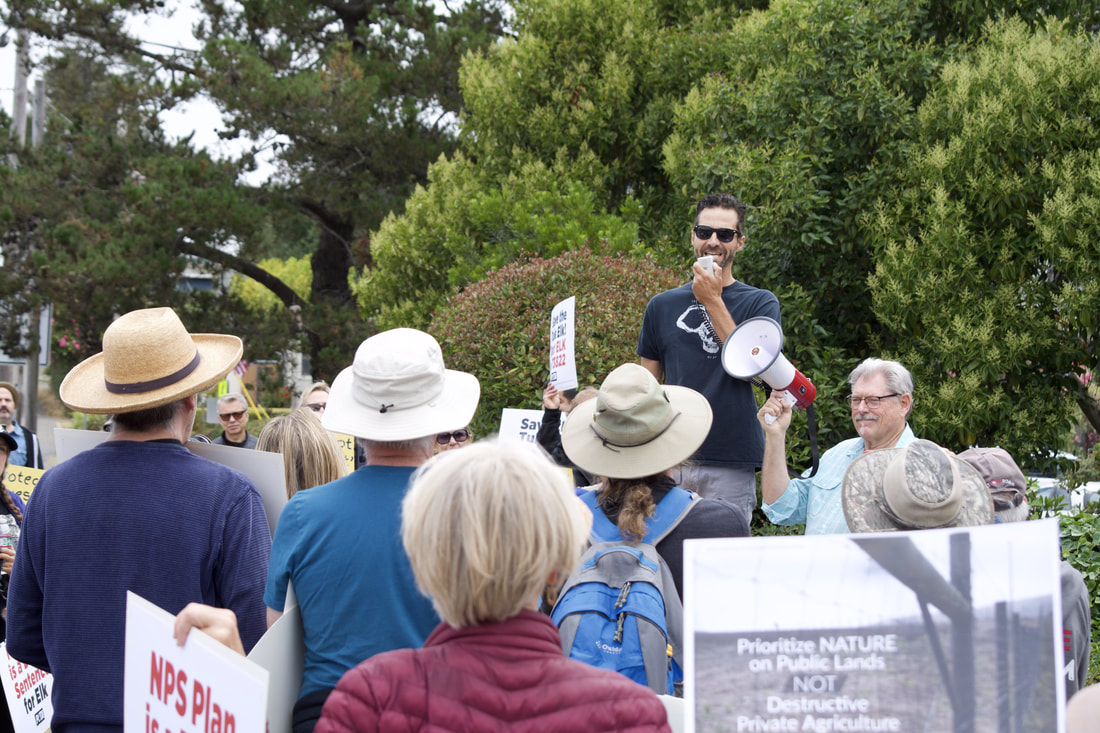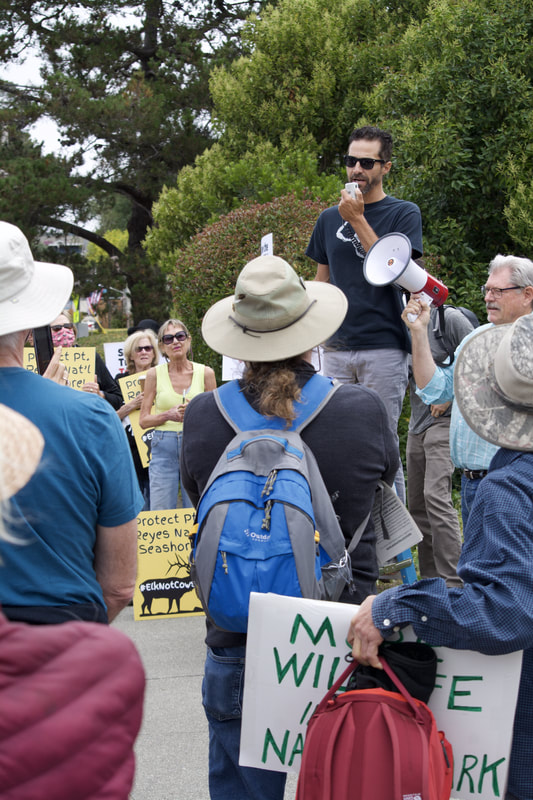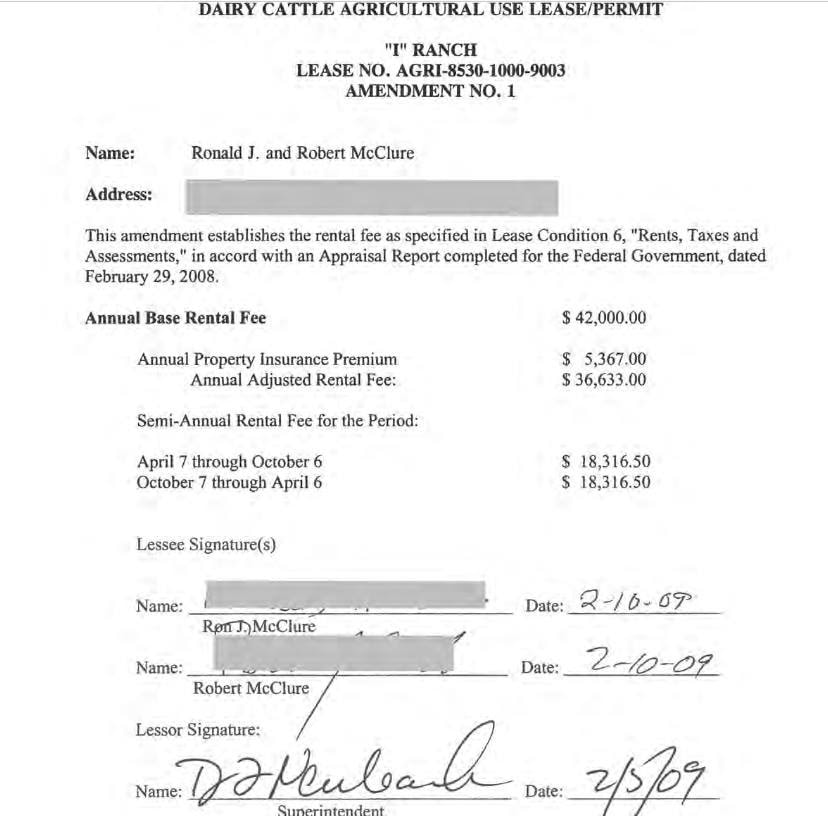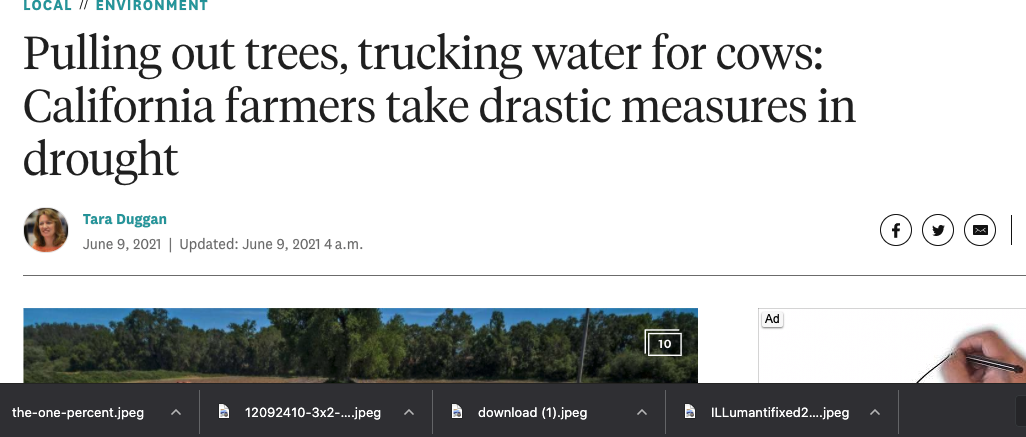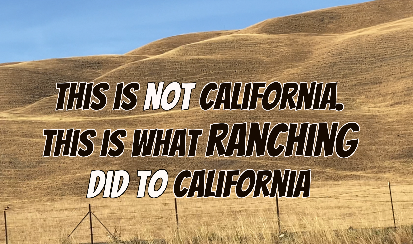|
Fact Checking FAQS
After Sunday's demonstration I went to the elk reserve and a few thoughts came to mind as I looked at the water troughs the park service provided. In particular I thought of things I had just read on their website’s FAQ page. 1 Water Quality Concerns The park claimed to be concerned about the quality and source of water the activists brought in. That would be inspiring unless you’re aware of the incredibly disgusting water the park WAS fine with claiming were adequate water sources for the elk. Talk about potential for infection! The puddles I saw out there screamed “drink me and die”. 2 Wilderness The park claimed that they made a special effort to place their troughs outside of designated wilderness areas. I have two responses to that: 1. The troughs seem to be in about the same spots so I’m curious exactly how designated and non designated wilderness is divided out there. 2. If this is designated wilderness then it is a testament to the failure of the park service to restore native coastal prairie. Instead the area was dominated by nonnative plants which can be traced back to ranching. 3 Working with the public The park claimed the public didn’t work with them to bring in troughs. Well, I guess that’s technically correct, but this is because the park was unwilling to bring in water under any conditions. Any and all proposals and even offers to provide volunteer labor were rejected. Next thing we knew, the park had brought in water (even while continuing to claim no water was needed). 4 Water access Lastly, you just have to pretend every animal in the reserve (including but not limited to just the elk) marched like well-trained cattle to the new water troughs at the southern tip of the reserve. This video shows the third of three troughs. It is the furthest north yet it's just south of Pierce Point Ranch. Just providing a little perspective for those who are thinking everything is OK now. #elk #elkwater #Tuleelk #FAQs #facts #pointreyes #water #watertroughs #shameofpointreyes #skylerthomas #pointreyesnationalseashore #drought #wildlife
0 Comments
I was asked by people in the crowd for a copy of my speech so I uploaded it here. Phots by Derek Clary It’s hard to believe it was the summer of 2018 that I began documenting issues in Point Reyes National Seashore…four summers ago.
And it’s hard to believe that those four years have been filled with the discovery of even more shocking and disturbing information. And I’ve got to say that I am tired... I’m tired of not even wanting to enter what was once a favorite place to visit because my awakened eyes tell me a depressing story, not an inspiring one. I know too well the extent of suffering taking place. I’m tired of Park Service staff that sound more like the politicians and lobbyists hired to amend the park’s legislation rather than sounding like wildlife ecologists. I’m tired of looking out over the pastoral wasteland where once an incredibly biodiverse habitat stood while hearing from the Marin conservation league that it is a marriage of wildlife and agriculture. Yes, a marriage where one spouse is bulldozed and shot by the other spouse. I’m tired of hearing the story of small struggling ranch families when in reality over 80% of the ranches on the Point Reyes National Seashore are leased to FOUR families, whose collective land holdings in Marin County total over 24,000 ACRES. I’m tired of hearing about multi generational families and how important the land is to these so-called stewards while we simultaneously ignore 10,000 years of a culture whose people actually did live with the land for millennia rather than bringing it to its knees in only a couple hundred years. I’m tired of ‘historical’ meaning a stubborn dedication to a hand-selected, relatively brief, and very destructive period in history. We stay cemented in a past that dooms us rather than evolving, adjusting and doing what is best for the future. I’m tired of hearing about the economic importance of the ranches even as more state and federal funds are shelled out just to keep the dying industries alive. In the meantime, the preserved portions of the park, the intrinsic value of nature, which costs us nothing, brings in economic spending that dwarfs that of the ranches. I’m tired of the self-declared most intelligent species on the planet declaring that another mammal species does not need his or her mother after birth for no reason other than economics; an industry that can only exist by stealing pregnancy lactations from a childless mother. I’m tired of seeing “conserve water” signs in communities that are blindly dedicated to what is about the most intensely water demanding industry you could think of. Take down your signs, Inverness and Point Reyes Station. I’m tired of the word sustainable being used to describe something shockingly unsustainable. And I’m tired of locals being intimidated into silence. It is time to rise up. Because the California Coastal Commission isn’t going to do the right thing. The Marin County Board of Supervisors won’t do the right thing. The Marin Conservation League and other so-called conservation groups (consisting of and influenced by ranchers) are not going to do the right thing. Politicians will not do the right thing and a Park Service that ignores its own environmental impact studies, will not do the right thing. Until we stop letting them off the hook.
So...about that water source map...and about those updates....
1. I first saw the water source map in September of 2020. Even then it wasn't accurate, being as how most of the blue dots and lines indicating water would have more appropriately been colored brown to represent the dirt and mud that was actually there. 2. This map was supposedly updated after park staff closely monitored the water situation in October of 2020. That update turned out to be a lie. ​ 3. Recently the park service updated their website stating "As of March 30, 2021: Park staff mapped water sources and monitored water conditions at Tomales Point on a regular basis during drought conditions this last year, confirming adequate water supplies were available to the elk in the many creeks, seeps, and springs distributed throughout the reserve." They once again provided the same map they provided in September of 2020 to go along with their update. No matter how you feel about the elk or ranching, shouldn't the park service be held accountable for misleading the public...repeatedly? Go to change.org/pointreyes if you thinks so. #watermap #pointreyes #elkwater #tuleelk #pointreyesnationalseashore #drought #lies #deception #melaniegunn #davepress #craigkenkel #elk #tomalespoint #elkfence #elkreserve #ranching #dairy
Watch for the full breakdown. Read below for a summary
Park Service Delivers Water to Tomales Point: Morning Cup of Cow Shit
This episode walks you through everything wrong and contradictory with the park service's recent actions even when they seem to finally do something good. 1. The park service has argued against elk advocates that the elk don't need water, but are instead dying from a lack of quality forage / malnutrition. So if their goal is to help the elk why would they bring water, which they claim the elk ARE NOT lacking, rather than forage that they claim the elk ARE lacking? It's not that I don't want water there, but the park is contradicting itself. Do they really want to help the elk or is this nothing more than a gesture to try and get pressure off of them? 2. In the past, when the park service was pressured heavily to help the elk, the park service would claim they are looking into bringing in water (but never did). When they were pressured further they changed their excuse to stating the elk management plan prevents them from interfering with the elk die-offs. If the management plan truly bound their hands how is it that their hands aren't bound now? 3. The park service continues to lie and get away with it. For the third time the exact same map has been presented to the public as a supposedly "updated water map" based on recent monitoring of the water sources. Please tell me how a map that wasn't updated is also considered "updated". Please also tell me how each and every water source on the map is exactly the same as it was each time before. 4. It's disturbing to me that tourists hike out to Tomales Point, see the disgusting and almost dry pond at the very northern end and conclude this means the elk have water. You're simply not thinking this through, at least not from the perspective of a wild animal. They have home ranges for one. Tomales Point is fairly large, a disgusting mud puddle at one end isn't sufficient for every animal out there and even if it was sufficient is NOT USED by every animal out there. How do people conclude after 254 elk die followed by another 152 elk dying that there wasn't a problem just because they saw a pond on their one time trip to the park? #elk #tuleelk #pointreyes #pointreyesnationalseashore #tomalespoint
Perspective to set the tone: McClure's "downsized" dairy will still use up to 2 million gallons of water per year.
The Point Reyes Light misleads the public with a shocking amount of pro-ranching bias in their article about McClure Dairy. Let me walk you through the deception paragraph by paragraph.
The Point Reyes Light article is pasted below, paragraph by paragraph, colored in red, bolded and italicized, followed by my critiques in black.
Tomales Point rancher Bob McClure, the fourth generation on Point Reyes is shutting down his dairy this month. The spring that feeds the ranch is running dry, there is a glut in the organic milk market and he does not have a successor. He has moved to Petaluma, but plans to raise a small number of heifers on the land, which was one of six dairies in the park.
Bob McClure is closing his dairy operation in the Point Reyes National Seashore, putting an end to the largest and oldest dairy in the park and leaving the eight families who live on the land without housing or work.
The McClures have lived on the peninsula for four generations, longer than any ranching family on the point. But a number of factors—with drought at the top of the list—have pushed Mr. McClure to sell his herd of 650 cows and lay off his staff.
“I’m a dairyman to the core, but there’s another life out there—and I want to see it before I’m six feet under,” he told the Light this week.
The closure comes on the eve of the National Park Service amending the seashore’s general management plan to offer 20-year ranch leases, following six decades of short-term agreements. Mr. McClure said he plans to negotiate a lease to raise heifers in an operation that would be far smaller and gentler on the land. For now, he is keeping 150 young cows to graze.
The McClure Dairy takes center stage in this horrifying video of Point Reyes
Mr. McClure is 60 and none of his three daughters want to take on the business after him. He has had four eye surgeries that left him vulnerable to the wind and sun. He wants to travel and spend more time with his wife, Ruth, on their small ranch in Petaluma, where she works. But although these personal factors underlie his decision, he said the main reason for shutting down was the fear of running out of water.
The drought in Marin is the worst since 1977, and it has the potential to become the worst ever. Already, farmers are scaling back their crops or skipping the season altogether, and ranchers are making plans to truck in water and upgrade their collection systems. Only 15 inches of rain have fallen in Inverness this winter, the driest year on record. The winter before was not much better, with 23 inches of rain, compared to an average of 37.5 inches.
The McClure ranch relies on a single spring that is historically abundant but is no longer recharging. At this time of year, the water typically overflows into Abbotts Lagoon, but water levels are instead falling—and at least five months without significant rainfall lie ahead.
Mr. McClure shares a pond with the neighboring Kehoe dairy as a backup, but if and when that source were to run dry, both dairies would have to either move their herds or truck in water, an expensive proposition. The McClure dairy uses an estimated 20,000 gallons of water each day, mostly for the cows to drink but also to wash manure out of the barn.
The lack of rain causes the grass to grow slower, so the dairy must purchase more feed to nourish the cows. Feed prices are rising because farmers are also facing water restrictions.
Beyond the drought, the economics of dairying are not as strong as they once were, Mr. McClure said. He sells his milk to Clover Sonoma, and the company sets his production limits and price per gallon. Values are down 30 percent from their peak due to a glut of organic milk producers, he said.
Last month, he sold 80 of his cows to an out-of-state buyer that he declined to name. The buyer was pleased, and he offered to purchase the rest of the herd. At a time when people are struggling to sell organic cows, Mr. McClure was enticed by the offer. He sat down with his family and they all encouraged him to sell. The first load went out on Tuesday and the rest will go over the next two weeks.
Mr. McClure said he may hire help after he transitions out of dairying, but once the lactating cows are gone, his business will have no income, he said. The consequences for the around 30 people who live on his ranch are enormous. The children attend local schools, and a few of the families have lived there for over 20 years. They have one month left of work and two months before they are expected to move out. No one knows what will come next.
“It’s like a really big bucket of cold water dumped on top of your head,” said Miguel Galarza, who has lived on the ranch with his wife and four kids for the last eight years.
Mr. McClure gathered his staff last week to break the news. He became emotional when he talked about that moment. “Super good guys,” he said. “Our success has always been from our employees.” Jesus Romo has been the dairy foreman for the last 22 years. He starts each day at 6 a.m., checking the cows and giving marching orders. He enjoys the job because the weather is pleasant, Mr. McClure is a cheerful boss and the housing is relatively nice. When he told his two daughters that they were moving, he said they started crying. “All of our lives were here,” he said. “This is part of my family.” He said he has no choice but to move on and look for work at another dairy. “I don’t know how to do anything else but taking care of cows—cows are my life,” he said. “It’s sad to move and do it somewhere else, but we have to keep going.” The displacement of families exposes the intrinsic problem with tying housing to employment. The last time this many West Marin families were displaced at once was when Drakes Bay Oyster Company closed in 2014; at that time, 32 mostly Hispanic men and women lost their jobs, and the 15 families who lived onsite had to move. The housing market has only become tighter and more expensive since then. “Trying to find homes for eight families right now when there are very little vacancies, and the urgency of having to find a home when you’re worried about public health, is very concerning,” said Leelee Thomas, a planning manager for Marin County. Rosa Rodriguez moved to Point Reyes two years ago from the Central Valley after her husband lost his job at another dairy. Her two older sons attend Tomales High, and the youngest goes to West Marin School. She appreciated being in an unpopulated area during the pandemic and is hoping the family can find another dairy close by, where her husband can keep milking cows and her children can stay in class. “It could destroy our education. It’s very hard for someone to focus when a lot of things are happening,” she said. “We don’t have a lot of options. There aren’t a lot of jobs, or places to live.”
The future of the McClure ranch will depend on an upcoming appraisal and the park’s lease terms. The National Park Service will officially update its management plan by July, after which appraisers will determine a fair market rent for each ranch. Rental rates will account for activities occurring on the ranch, so Mr. McClure will likely pay less for a downsized operation.
“We look forward to working with the McClures to identify a transition approach on I Ranch consistent with the General Management Plan amendment,” outreach coordinator Melanie Gunn wrote in an email. If Mr. McClure does not sign a lease, the park service would be guided by the succession policy outlined in the amendment. The policy says that if a rancher does not wish to enter into a new lease, the park would consider proposals from other leaseholders or ranch workers within the park. If none of them are interested in operating a ranch, then the park would pursue a public process to identify an appropriate future use of the land.
In recent years, the McClure ranch has become a target of anti-ranching and pro-elk activists; last fall, over 200 people staged a protest on the driveway. Mr. McClure didn’t have much to say on the matter; his dairy is not in the range of any elk herds. During the protest, he greeted them and observed.
Activist groups contracted water tests near his ranch this winter, and the tests showed bacteria levels that greatly exceeded recreational standards. But it was just two days of testing after rain, and credible water monitoring requires multiple tests over time to paint an accurate picture. No regular water monitoring has been conducted in the area since 2013, though the regional water board requires dairies to maintain records on manure application and storage, pasture and riparian conditions and more.
Mr. McClure said he complies with all of the rules. The cows go in the loafing barn during the winter to prevent manure from washing away, and the creek areas are fenced off, he said.
In his 38-year tenure, he remodeled the milking operation to make it more efficient and brought in new technology, like a no-till seed drill and automatic scrapers in the barns. Many of the improvements have been made to help conserve the environment, he said.
Even with the upgrades, the ranch retains its layout from the 1800s. Nine features predating 1925 are listed on the National Register of Historic Places, including the large hay barn built in the 1880s. From James to Jim to Ron and now Bob, the McClures have been milking cows on Point Reyes since 1889, when products traveled by schooner to San Francisco. James McClure bought his first dairy in 1906 and the family moved around to several ranches before leasing the I Ranch in 1930.
#mcclure #bobmcclure #mcclureranch #ranch #dairyranch #dairy #dairydamage #drought #iranch #pointreyes #pointreyesnationalseashore #pointreyesllight #manure #shameofpointreyes
Leases and Permits
Water Quality Control Board document
Link to An Administrative History of Point Reyes
https://www.nps.gov/parkhistory/online_books/pore/admin.pdf
Link to Ranching on the Point Reyes Peninsula
https://www.nps.gov/parkhistory/online_books/pore/ranching.pdf Here's a paragraph from the Press Democrat, June 9, 2021. "Dairy farms in western Sonoma that rely on surface water are also quickly running low. Since each dairy cow drinks 30 to 40 gallons of water a day, larger dairies whose ponds have almost dried up are trucking in 35,000 to 40,000 gallons of water A DAY from local water haulers, Tesconi said. Water truckers haul recycled municipal water provided by Sonoma County." It is concerning that in 2021 we are still a population that can read blaring evidence of exactly why we have no water and who is draining us dry, yet react by saying, "How can we help them use up whatever water is left?" The most unsustainable form of "food" production that exists, dairy, is also an industry experiencing a glut. Meaning we already have more than can be sold. Here's a quote from the New York Times. "The amount of waste is staggering. The nation’s largest dairy cooperative, Dairy Farmers of America, estimates that farmers are dumping as many as 3.7 million gallons of milk each day. And the only reason the portion of product that is being sold can be sold at the price it is sold is because we the taxpayers subsidize this industry with billions of dollars every year. We don't need it. We have too much. It drains the economy. It drains our rivers, lakes, and aquifers. Turns out it's not even healthy. Yet all we can say is, "Let's keep this going no matter what it takes." Recycled or not, all this water comes from somewhere. "Somewhere" is a real place that we conveniently keep as an abstract concept, but in reality means where that water is naturally meant to be, but is no longer there. In turn that means every living creature that needed that water no longer has it.
That means dead plants, dead animals, and topsoil that is ready to blow away in the wind because no organic matter has survived to hold it in place. #dairy #drought #dairyequalsdrought #sonoma #pressdemocrat #pointreyes |
TAX DEDUCTIBLEThis project is independent and self-funded. The time and financial investment is significant. Support is greatly needed and appreciated.
|
||||||||||||
- Blog
- The Film
- Donate
-
Truth isn't Easy
- MALT Considerations
- The Families (Overview Page) >
- Morning Cup of Cow Shit
- Adequate Water
- Regenerative Ranching Debunked
- An Ecologist's Tour of Point Reyes
- Wildlife Biologist 1
- Ignoring the Public
- Ranching Association
- All Bonus Video Material
- 50 Minutes of Destruction
- 45 Minutes of Marin Destruction
- Debunking Propaganda
- Calf Reality
- Cruelty: Standard Practice
- Plant Ecology Crash Course
- Take Action
-
Resources
- Regenerative Bullshit
- Fire
-
Documents
>
- An Administrative History
- Plants and Cattle
- Water Waivers
- Leases
- Point Blue Study - Ranching Harms Native Birds
- Ranching and Ravens - Audobon Study
- Responsive Management Survey
- FOIA / Rancher Violations
- PRNS Coastal Watershed Assessment
- Top Crappy Places
- An Administrative History of PRNS
- Original Legislation
- Ranchers Fighting Against the Seashore
- The Dynastic Wealth of Point Reyes Ranch Families
- 'This Land' - The Uncomfortable Truth
- Bruce Keegan History
- The New Threat
- Plan F
- Facts VS. Myths
- By The Numbers
- For Elk
- Nature in National Parks
- Sign Up
- Blog
- The Film
- Donate
-
Truth isn't Easy
- MALT Considerations
- The Families (Overview Page) >
- Morning Cup of Cow Shit
- Adequate Water
- Regenerative Ranching Debunked
- An Ecologist's Tour of Point Reyes
- Wildlife Biologist 1
- Ignoring the Public
- Ranching Association
- All Bonus Video Material
- 50 Minutes of Destruction
- 45 Minutes of Marin Destruction
- Debunking Propaganda
- Calf Reality
- Cruelty: Standard Practice
- Plant Ecology Crash Course
- Take Action
-
Resources
- Regenerative Bullshit
- Fire
-
Documents
>
- An Administrative History
- Plants and Cattle
- Water Waivers
- Leases
- Point Blue Study - Ranching Harms Native Birds
- Ranching and Ravens - Audobon Study
- Responsive Management Survey
- FOIA / Rancher Violations
- PRNS Coastal Watershed Assessment
- Top Crappy Places
- An Administrative History of PRNS
- Original Legislation
- Ranchers Fighting Against the Seashore
- The Dynastic Wealth of Point Reyes Ranch Families
- 'This Land' - The Uncomfortable Truth
- Bruce Keegan History
- The New Threat
- Plan F
- Facts VS. Myths
- By The Numbers
- For Elk
- Nature in National Parks
- Sign Up
